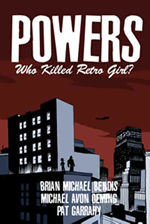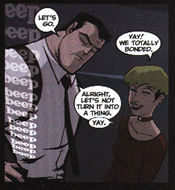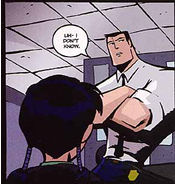>> The Friday Review: Zero Girl
>> The Friday Review: Ruse: Enter The Detective
More...

 Writer: Brian Michael Bendis
Writer: Brian Michael Bendis
Artist: Michael Avon Oeming
Colourist: Pat Garrahy
Separation Assists: Ojo Caliente Studios
Letterers: Pat Garrahy, Brian Michael Bendis
Collecting POWERS #1-6
Price: $21.95
Publisher: Image Comics
ISBN: 1582401837
With just the first page of POWERS: WHO KILLED RETRO GIRL?, author Brian Michael Bendis, with adroit efficiency, sets into place the key elements, both of form and execution, that will define not just this first six-issue story arc, but the entire series.
Within the first page's six panels, Bendis establishes his main character, Homicide Detective Christian Walker, with a sequence filled with rapid-fire dialogue. As the series begins, Walker has been summoned to a hostage situation; these first six panels illustrate Walker's arrival on the scene. Small word balloons pepper the page, visual hallmarks of the short and direct conversational style Bendis uses so effectively throughout the book.
Indeed, Bendis' main gift as a writer, as evidenced here and in his mainstream Marvel work, is for dialogue, and that strength is evident from the start. His style is naturalistic, almost Mametesque in its use of clipped phrases, half-formed thoughts and the unsaid bits that fill up the spaces in most real conversations.
At the same time, vital information is being given; we learn that Walker is a detective, that he's been called in to take care of a deranged, possibly super-powered individual who's taken a young child hostage, and that he had been at the movies when he got the call. And yet, none of this exposition is forced or obvious; we receive the information in the most natural and realistic of ways.
Those first six panels also set up Michael Avon Oeming and Pat Garrahy's distinctive artistic style. First, in the figures themselves: Oeming pencils in an almost cartoony style, in broad strokes and with strong lines (Walker's jaw line is a perfect example, almost perfectly rectangular and squared), and yet the art is coloured in a very realistic way, with effective use of shadows and the interplay of light. It's a clean look that achieves an almost paradoxical degree of realism - cartoon realism, perhaps.
Also established up front is Oeming's very idiosyncratic use of panels. The six panels that make up this first page are all wide horizontal panels, the width of the page and of equal height. In each, our view of the scene (Walker walking up the stairs into the apartment building while being briefed on the hostage situation) tightens, so that a scene that started as, in film parlance, a long shot, ends as a close up. This technique, the use of a series of static or near-static images in order to make room for a sizable amount of dialogue, is seen throughout the book.
 In short, Bendis and Oeming have developed a very unique and specific style for the book, one quite effective for the story they tell. That story relies on a variation of a conceit that in the past ten years has become quite in vogue - superhero stories as told from new viewpoints. Kurt Busiek did it in MARVELS and ASTRO CITY, Alan Moore is doing it in TOP TEN and Bendis himself is doing a variation of it in ALIAS - superhero tales as told by other witnesses.
In short, Bendis and Oeming have developed a very unique and specific style for the book, one quite effective for the story they tell. That story relies on a variation of a conceit that in the past ten years has become quite in vogue - superhero stories as told from new viewpoints. Kurt Busiek did it in MARVELS and ASTRO CITY, Alan Moore is doing it in TOP TEN and Bendis himself is doing a variation of it in ALIAS - superhero tales as told by other witnesses.
In the case of POWERS, the series follows the cases of Christian Walker and Deena Pilgrim, homicide detectives assigned specifically to cases dealing with the Powers - this particular universe's term for superheroes.
WHO KILLED RETRO GIRL?, collecting the first six issues of POWERS, deals specifically with the case of Retro Girl, a vaguely Supergirl-esque superhero whose murder opens the series. Issue one, besides setting up the basic plot (who killed Retro Girl, natch) sets up the partnership of Walker and Pilgrim.
t is the relationship between these two detectives, more specifically the forging of it, that forms the real core of the story. To say too much would be to ruin some of the more effective twists of the story; suffice it to say that Bendis has crafted an interesting and viable dynamic between his two protagonists, and that the gradual unfolding of this dynamic gives the book a fine characterization arc.
And it bears repeating again that much of this characterization is accomplished through that wonderfully naturalistic and real dialogue. Witness just one example:
Pilgrim: Poor kid was filthy. She had funky butt.
Walker: Funky butt?
Pilgrim: Total funky butt.
Walker: Do I have funky butt?
Pilgrim: See you tomorrow, Walker.
Walker: I'm serious.
Pilgrim: I know. That's so sad.
These are very specific characters Bendis has drawn, with their own speech patterns and vocal quirks. And this specificity extends to the supporting characters, from a scheming rival detective to a precocious orphaned little girl to a frustrated coroner - all very specific individuals, not the standard types so often used by comic book writers.
WHO KILLED RETRO GIRL? Is not just a talking heads book, however. While not as action-oriented a title as something like THE AVENGERS or SUPERMAN, the book does afford Oeming the opportunity to illustrate some tense and kinetic physical scenes.
 Typical of comics like this, comics that imagine an entirely new superhero universe and then examine it from a new point of view, are backgrounds and cityscapes jam-packed with superheroes and sly jokes and allusions to existing superheroes from established comic book universes.
Typical of comics like this, comics that imagine an entirely new superhero universe and then examine it from a new point of view, are backgrounds and cityscapes jam-packed with superheroes and sly jokes and allusions to existing superheroes from established comic book universes.
This kind of tactic can be quite effective - see Alan Moore's TOP TEN for one example. Here, Bendis avoids such tactics - probably wisely, given the film noir atmosphere of the piece - though he does provide Oeming with one sequence in which the artist can play with this kind of visual excess, as Walker and Pilgrim interview a procession of superheroes and villains as part of their investigation.
As part of the supplementary material included in the Definitive Edition of the book, Bendis explains that, for this sequence, he solicited designs for these heroes and villains from friends in comics, and it's amusing to look through the list of Oeming-illustrated superheroes and see who contributed what character.
For the most part though, Oeming is spared the task of filling every available frame with background characters and references. This leaves him the space to lavish attention on the city itself, and he is more than up to the task. One caveat: there are a handful of panels in which the artwork appears almost pixilated, or slightly blurry, almost as if there was a mix-up in production. While most likely just a glitch, it is distracting, and I wonder why it wasn't caught, or, if it is intentional, what on earth the purpose could be.
The features included in the Definitive Edition gives WHO KILLED RETRO GIRL? the comics-equivalent feel of a feature-packed DVD: In addition to the six issues themselves, the book includes eight pages of strips that ran in COMIC SHOP NEWS as a teaser to the actual series; the complete script of issue one; 17 pages of character sketchbook material; another five pages of sketchbook material of the city; a complete gallery of covers, unused covers and preliminary cover sketches; and a key to the aforementioned cameos of characters from other universes.
Upon its release,WHO KILLED RETRO GIRL? was an immediate hit, selling out its first printing. Rather than just reprint after the first batch was gone, Image produced two different editions the second time around, reprinting the full trade with a new cover as well as a new, cheaper version containing just the story arc with none of the extras. That second version is unfortunately rather difficult to track down, but the extras in the Definitive Edition make it worth the price.
After this promising debut storyline, POWERS has begun to feel ever so slightly routine, though it remains a good read, and this first story arc is still a fine combination of the crime and superhero genres and an excellent showcase for Bendis' skills as a writer.

This article is Ideological Freeware. The author grants permission for its reproduction and redistribution by private individuals on condition that the author and source of the article are clearly shown, no charge is made, and the whole article is reproduced intact, including this notice.


